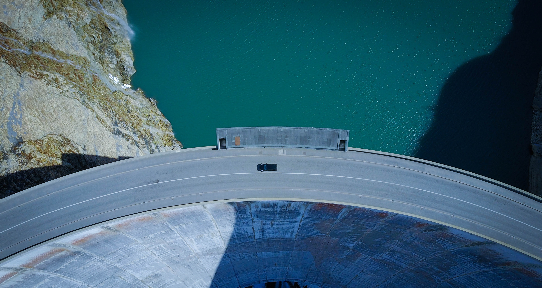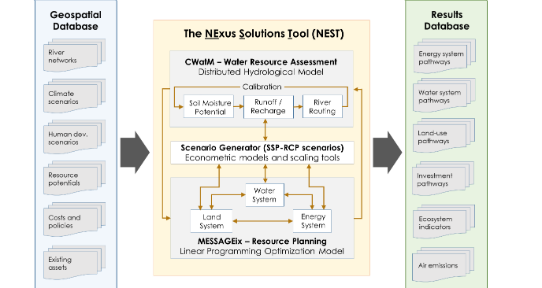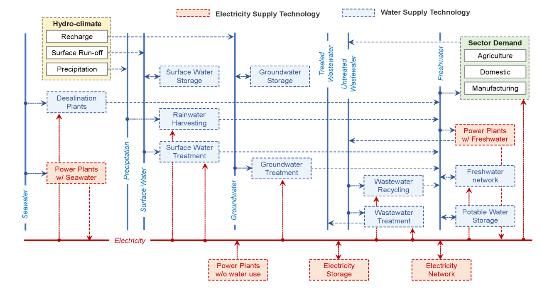Integrated Assessment of the Water-Energy-Land Nexus

Today, more than 2 billion people in the world do not have access to modern cooking fuels or sanitation, and almost 1 billion do not have access to electricity or clean water, or go hungry every day. Humanity has already reached or even exceeded the carrying capacity of several of the earth’s ecosystems. Growing needs for food, energy and water will only exacerbate existing challenges over the next decades.
Given the interdependencies, the sustainable management of water, energy, and land resources should be conducted using integrated approaches that are based on a broader systems perspective. A nexus approach gives equal weight to each sector (including the environmental needs) and strives to identify the interactions among sectors to better understand the synergies and trade-offs involved in meeting future resource demands in a sustainable way. The ultimate objective is to identify solutions that capitalize on potential synergies and co-benefits, minimize counterproductive policies, and ensure that humanity remains within planetary boundaries.
IESVic’s research on the water-energy-land nexus focuses on the systems engineering representation of long-term technology transformation, and the linking of transformation pathways to the achievement of multiple policy objectives. Primary applications include the assessment of infrastructure and investments needed to support implementation of the Paris climate agreement and the Sustainable Development Goals (SDGs).
The research is undertaken in close collaboration with the International Institute for Applied Systems Analysis (IIASA).
End-users of the research include the United Nations Industrial Development Organization, the Asian Development Bank and the Global Environment Facility, as well as a number of local planning authorities featured in the regional case study analyses.
Researcher
Muhammad Awais (PhD Candidate, Civil Engineering / Research Assistant, IIASA)
Steering Committee
Dr. Andrew Rowe (Director, IESVic / Professor, Mechanical Engineering, UVic)
Dr. Ned Djilali (Professor, Mechanical Engineering UVic)
Dr. Madeleine McPherson (Assistant Professor, Civil Engineering, UVic)
Dr. Keywan Riahi (Director, Energy Program, IIASA)
Dr. Volker Krey (Deputy Director, Energy Program IIASA)
Dr. Edward Byers (Research Scholar, IIASA)

Recent Publications
- Vinca, et al., The Nexus Solutions Tool (NEST) v1.0: An open platform for optimizing multi-scale energy-water-land system transformations, Geoscientific Model Development. In Press (2020).
- Hunt, et al., Global potential of seasonal pumped hydropower for water and energy storage. Nature Communications, 11: 947 (2020). doi
- Falchetta, et al., Monitoring hydropower reliability in Malawi with satellite data and machine learning. Environmental Research Letters, 15: 014011 (2020). doi
- Zhou, et al., Decarbonization pathways and energy investment needs for Developing Asia in line with well below 2 °C. Climate Policy. 20: 234-245 (2020). doi.
- Wada, et al., Co-designing Indus water-energy-land futures. One Earth, 1(2): 185-194 (2019). doi
- Wang, et al.. Vulnerability of existing and planned coal-fired power plants in Developing Asia to changes in climate and water resources, Energy & Environmental Science, 12: 3164-3181 (2019). doi
- Johnson, et al., Integrated solutions for the water-energy-land nexus: Are global models rising to the challenge? Water (SI: Water-Energy-Food Nexus), 11: 2223 (2019). doi
- Falchetta, et al., A high-resolution gridded dataset to assess electrification in Sub-Saharan Africa, Scientific Data, 6(1): 110 (2019). doi
- D. Rao, et al., Spatial analysis of energy use and GHG emissions from cereal production in India, Science of the Total Environment, 654: 841-849. doi
- Parkinson, et al., Balancing clean water-climate change mitigation trade-offs, Environmental Research Letters 14: 014009 (2019). doi
- Kahil, et al., A continental-scale hydro-economic model for integrating water-energy-land nexus solutions. Water Resources Research, 54: 7511-7533 (2018). doi
- L. McCollum, et al., Energy investment needs for fulfilling the Paris Agreement and achieving the Sustainable Development Goals, Nature Energy, 3: 589–599 (2018). doi
- Byers, et al., Global exposure and vulnerability to multi-sector development and climate change hotspots, Environmental Research Letters, 13: 055012 (2018). doi
- Liu, et al., Quantifying the potential for reservoirs to secure future surface water yields in the world’s largest river basins, Environmental Research Letters, 13: 044026 (2018). doi
- L. McCollum, et al., Connecting the Sustainable Development Goals by their energy inter-linkages, Environmental Research Letters, 13: 033006 (2018). doi
- Khan, et al., Spatial and temporal synchronization of water with energy systems: Towards an integrated optimization model for long-term resource planning, Applied Energy (SI: Energy-Water-Food Nexus), 210: 499-517 (2018). doi

